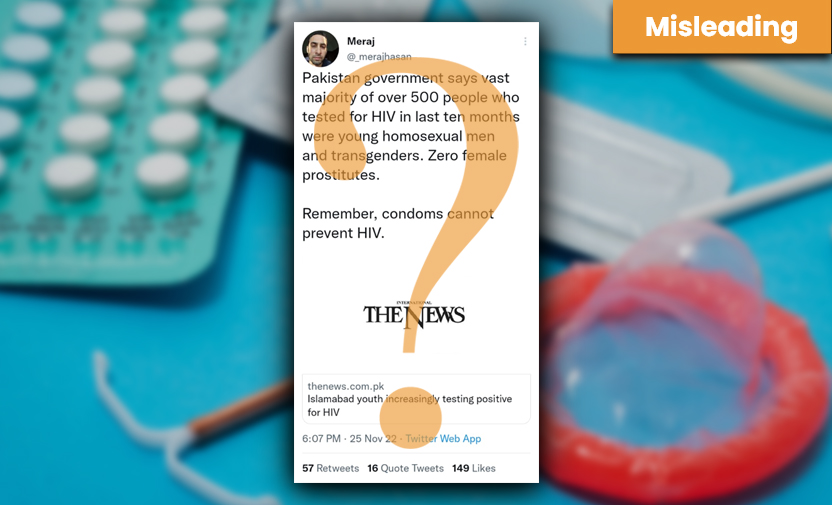
Claim: A social media post claims that “condoms cannot prevent HIV” amid reports of a rise in HIV-positive cases in Pakistan’s capital, Islamabad.
Fact: Condoms are the most effective method to prevent HIV when used properly and consistently, according to multiple reputable public health organisations around the world, including the UNFPA, WHO, UNAIDS, CDC, NHS, CATIE, NIAID, HRW, FDA, and Planned Parenthood, as well as rigorous scientific studies.
On 25 November 2022, Twitter user @_merajhasan shared a report by The News titled, Islamabad youth increasingly testing positive for HIV, with the caption:
“Pakistan government says vast majority of over 500 people who tested for HIV in last ten months were young homosexual men and transgenders. Zero female prostitutes.
Remember, condoms cannot prevent HIV.”
Condoms are both a contraceptive and a method to protect oneself from infection during sexual intercourse. There are two types of condoms: external, which are used by people who have penises, and internal, which are used by people who have vaginas.
The tweet by @_merajhasan, who has more than 11,000 Twitter followers, went viral and ignited a debate about what they claimed is a “promiscuous lifestyle” and “sexual perversions”.
Fact or Fiction?
There are multiple reliable public health sources that detail the effectiveness of condoms in preventing HIV. Soch Fact Check has listed excerpts from some of those below:
In a position statement released July 2015, the United Nations Population Fund (UNFPA), World Health Organization (WHO), and the Joint United Nations Programme on HIV/AIDS (UNAIDS) state, “Male and female condoms are the only devices that both reduce the transmission of HIV and other sexually transmitted infections (STIs) and prevent unintended pregnancy.”
“A recent global modelling analysis estimated that condoms have averted around 50 million new HIV infections since the onset of the HIV epidemic,” the three organisations added.
According to the United States’ Centers for Disease Control and Prevention (CDC), “Most condoms are highly effective in preventing HIV and certain other sexually transmitted diseases (STDs), like gonorrhea and chlamydia. [They also] help prevent HIV for higher risk sexual activities like anal or vaginal sex.”
The CDC mentions that external latex condoms are the best protection against HIV, while nitrile internal condoms prevent HIV from travelling through the nitrile barrier. The organisation’s guide about the prevention of HIV and the use of condoms is available here.
The United Kingdom’s National Health Service (NHS) terms condoms “the best way to prevent sexually transmitted infections (STIs) such as HIV”. It adds that they are “most effective when used properly [and consistently], which includes using one that is the right size”.
The Canadian AIDS Treatment Information Exchange (CATIE) states, “Laboratory studies show that the materials used to make most condoms (such as latex, nitrile, polyurethane and polyisoprene) do not let HIV pass through them.
“Condoms act as a barrier to HIV infection by preventing the vagina, penis, rectum and mouth from being exposed to bodily fluids (such as semen, vaginal fluid and rectal fluid) that can contain HIV,” the CATIE adds.
As per the National Institute of Allergy and Infectious Diseases (NIAID), one of the earliest recommendations to prevent HIV at the start of the early 80s HIV/AIDS (acquired immune deficiency syndrome) epidemic was the “consistent and correct condom use”.
It further notes that “condoms are recommended for use in conjunction with other HIV prevention tools, such as pre-exposure prophylaxis (PrEP)” for individuals who meet certain risk criteria.
A 1997 study titled ‘Effectiveness of condoms in preventing HIV transmission’ by Professors Steven D. Pinkerton and Paul R. Abramson indicates that condoms are “90 to 95% effective when used consistently, i.e. consistent condom users are 10 to 20 times less likely to become infected when exposed to the virus than are inconsistent or non-users”.
Pinkerton is an Associate Professor of Psychiatry and Behavioral Medicine at the Medical College of Wisconsin, while Abramson is a Research Professor at the University of California, Los Angeles’ (UCLA) Department of Psychology. The two have co-authored the book, “With Pleasure: Thoughts on the Natures of Human Sexuality.”
In a 2003 editorial titled, ‘Don’t overlook condoms for HIV prevention’, Paul J. Feldblum, Michael J. Welsh, and Michael J. Steiner say that hindrances include “stigma, myth, and rumour surrounding condoms” and that researchers consistently get to hear that “condoms are ineffective” and “cause promiscuity”.
‘The impact of condom use on the HIV epidemic’, a 2021 study by John Stover and Yu Teng, concludes that the “current levels of HIV would be five times higher without condom use and that the scale-up in condoms use averted about 117 million HIV infections”.
The Human Rights Watch (HRW) has said in a briefing paper that condoms “provide an essentially impermeable barrier to HIV pathogens”.
Claims that the HIV virus is smaller than the pores in condoms and can therefore pass through — such as the ones American journalist Nicholas D. Kristof mentioned he received in emails in 2003 — have been debunked in the HRW paper, as well as by VERA Files, a signatory of the International Fact-Checking Network (IFCN).
“A study done by US Food and Drug Administration scientists in 1997 revealed that the latex membrane of condoms are ‘normally impervious to virus passage’ and holes occurred ‘infrequently,’” VERA Files wrote in 2017.
The American nonprofit organisation Planned Parenthood, which provides reproductive healthcare, also debunked the claim in 2010.
Virality
Soch Fact Check found the misleading claim here, here, and here on Twitter, as well as on Facebook here and here.
Conclusion: The claim is misleading. Condoms are the most effective method to prevent HIV according to public health organisations around the world.
Background image in cover photo: Reproductive Health Supplies Coalition
